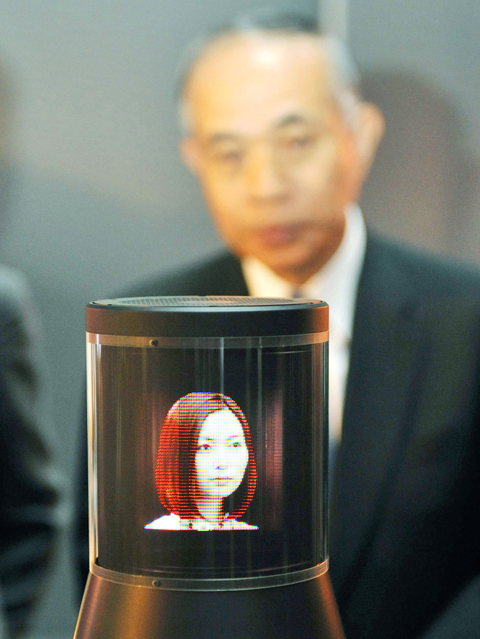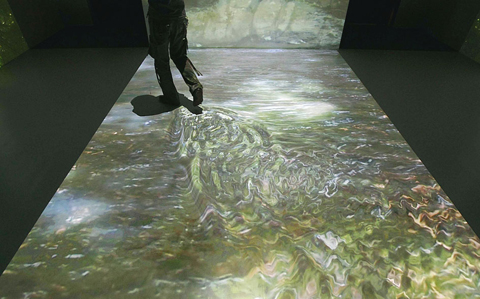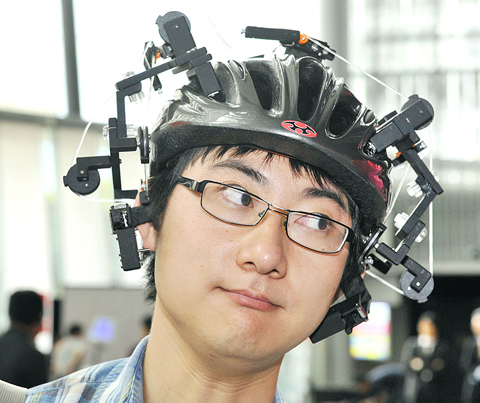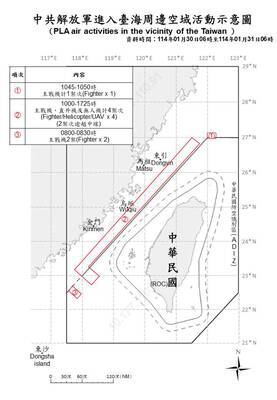A monster-slaying bad breath blow gun, a rain-simulating “funbrella” and a navigation-aid helmet that steers users by pulling a wearer’s ears: Welcome to Japan’s latest wacky inventions.
These bizarre gadgets and more — some of them useful, most of them fun — went on display at the Digital Content Expo, a fair showcasing futuristic gaming, arts, medical and other technologies that opened on Thursday.
A clear crowd-pleaser at the four-day event was a blowgun videogame by the Kanazawa Institute of Technology where the enemies are a scary lineup of monsters including a vampire, a bat and a club-wielding ogre.

PHOTO: AFP
Rather than fire bullets, darts or lasers at the fearsome adversaries, players of all ages eat snacks and sip drinks to boost the smell of their breath, then blast stinky bad breath balls at the screen to kill the monsters.
“Your children may shun you when you come home reeking of alcohol, but this could make you a family hero,” said Yusuke Sasayama, a Kanazawa Institute engineering student and one of the brains behind the game.
Osaka University graduate students, meanwhile, wowed audiences with their “Funbrella” — the perfect gift for people who hate sunny days — which uses a technology the inventors called the “tele-rain” system.

PHOTO: REUTERS
A vibrating device on the gadget simulates the sensation of raindrops hitting the umbrella, and there are advanced settings for hails of marbles, snakes and other objects that don’t usually fall from the sky.
“With this ‘Funbrella’ you could feel an Amazon downpour in the desert,” said Yoshifumi Kitamura, associate professor at the university.
He also suggested it could help lovers who are separated by vast distances to share the feeling of braving a rainstorm together as they talk by telephone.

PHOTO: AFP
For those with little sense of direction, Yuichiro Kojima, a researcher at the University of Electro-Communications, has come up with an alternative to GPS and navigation systems or the humble compass and map.
His head-mounted device steers users by gently pulling their ears.
One team member said it was inspired by “parents towing their children and pulling their ears, which allows you to lead people with gentle force.”
In one of the breakthoughs at the show, electronic powerhouse Sony Corp showed off a world-first device — a cylindrical three-dimensional display where the image can be viewed from any angle.
“It is unprecedented that you can see a 3D image from 360 degrees and in full color,” Sony spokeswoman Saori Takahashi said of the device, about the size of a coffee maker.
“This could be used for education or as a 3D photo frame in the future,” she said. “If we can adapt this for motion pictures, it would lead to a 3D video-phone or to virtual pets.”

UNITED: The premier said Trump’s tariff comments provided a great opportunity for the private and public sectors to come together to maintain the nation’s chip advantage The government is considering ways to assist the nation’s semiconductor industry or hosting collaborative projects with the private sector after US President Donald Trump threatened to impose a 100 percent tariff on chips exported to the US, Premier Cho Jung-tai (卓榮泰) said yesterday. Trump on Monday told Republican members of the US Congress about plans to impose sweeping tariffs on semiconductors, steel, aluminum, copper and pharmaceuticals “in the very near future.” “It’s time for the United States to return to the system that made us richer and more powerful than ever before,” Trump said at the Republican Issues Conference in Miami, Florida. “They

GOLDEN OPPORTUNITY: Taiwan must capitalize on the shock waves DeepSeek has sent through US markets to show it is a tech partner of Washington, a researcher said China’s reported breakthrough in artificial intelligence (AI) would prompt the US to seek a stronger alliance with Taiwan and Japan to secure its technological superiority, a Taiwanese researcher said yesterday. The launch of low-cost AI model DeepSeek (深度求索) on Monday sent US tech stocks tumbling, with chipmaker Nvidia Corp losing 16 percent of its value and the NASDAQ falling 612.46 points, or 3.07 percent, to close at 19,341.84 points. On the same day, the Philadelphia Stock Exchange Semiconductor Sector index dropped 488.7 points, or 9.15 percent, to close at 4,853.24 points. The launch of the Chinese chatbot proves that a competitor can

TAIWAN DEFENSE: The initiative would involve integrating various systems in a fast-paced manner through the use of common software to obstruct a Chinese invasion The first tranche of the US Navy’s “Replicator” initiative aimed at obstructing a Chinese invasion of Taiwan would be ready by August, a US Naval Institute (USNI) News report on Tuesday said. The initiative is part of a larger defense strategy for Taiwan, and would involve launching thousands of uncrewed submarines, surface vessels and aerial vehicles around Taiwan to buy the nation and its partners time to assemble a response. The plan was first made public by the Washington Post in June last year, when it cited comments by US Indo-Pacific Commander Admiral Samuel Paparo on the sidelines of the Shangri-La Dialogue

MARITIME SECURITY: Of the 52 vessels, 15 were rated a ‘threat’ for various reasons, including the amount of time they spent loitering near subsea cables, the CGA said Taiwan has identified 52 “suspicious” Chinese-owned ships flying flags of convenience that require close monitoring if detected near the nation, the Coast Guard Administration (CGA) said yesterday, as the nation seeks to protect its subsea telecoms cables. The stricter regime comes after a Cameroon-flagged vessel was briefly detained by the CGA earlier this month on suspicion of damaging an international cable northeast of Taiwan. The vessel is owned by a Hong Kong-registered company with a Chinese address given for its only listed director, the CGA said previously. Taiwan fears China could sever its communication links as part of an attempt